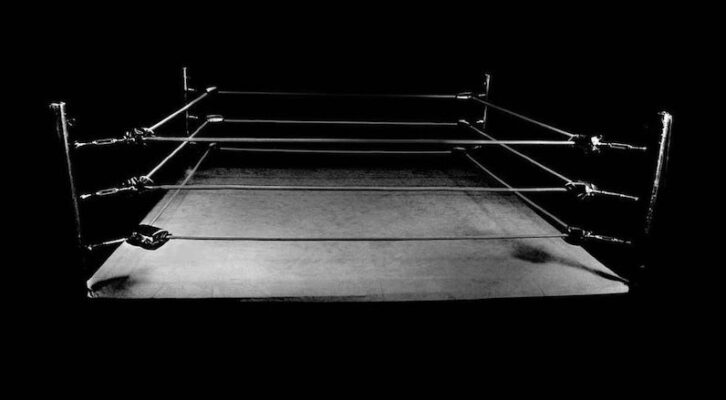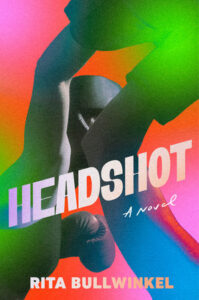
Rita Bullwinkel on Writing Sports Narratives
The Great Divide Between Playing and Watching
This first appeared in Lit Hub’s Craft of Writing newsletter—sign up here.
I wrote Headshot because I wanted to remember what it felt like to be obsessed with playing a sport that nobody was watching. Many literary sports narratives, such as Joyce Carol Oates’s On Boxing, don’t help me remember this feeling because they are texts that are primarily interested in what it feels like to watch a sport, but there are some, rarer, narratives that circle what it feels like to play a sport, what it feels like to be solitary and embodied, and when I read those texts I am able to see a sliver of a former self. Reading those rare texts is like standing on the street at night and, through a large glass illuminated window, watching a former me walk brazenly around in a house unaware. It’s uncanny, and intoxicating, to glimpse a past self like that. Narratives that make me feel this way, that remind me what it feels like to be obsessed with playing a sport, electrify me.
Texts that capture this feeling include:
“The Beauty of a Busted Fruit” by Natalie Diaz
“The Death of Me” by Gordon Lish
“Against Exercise” by Mark Greif
Lord of Misrule by Jaimy Gordon
Kick the Latch by Kathryn Scanlan
“All American” by Diane Williams
How to Wrestle a Girl by Venita Blackburn
Swimming Studies by Leanne Shapton
The way Mark Baumer wrote about baseball
The way David Foster Wallace describes tennis in Infinite Jest
Demand Utopian Sports: A Manifesto, especially the introduction by Justin Carder and “Living in Your Own Private Nowhere Place” by Jordan Karnes
For a period of time a version of the above list of texts lived at the end of the google doc in which I composed Headshot, a novel about a youth women’s boxing tournament in Reno, and the strange way that the playing of games has the ability to form a collective memory.
I wanted Headshot to be a book about what it felt like to play a sport that very few people were watching.
Looking back on this list of texts now, it is noteworthy that “The Beauty of a Busted Fruit” by Natalie Diaz and “All American” by Diane Williams actually make no mention of sports, but they’re still totally soaked through in the feeling I was chasing. “The Beauty of a Busted Fruit”, like much of Natalie Diaz’s work, is deeply embodied. It’s about how a wound might be a wound, or how a wound, depending on how you wear it, might actually be a source of power.
In Williams’s “All American” a little girl forcibly kisses her sister. It’s a story about what you can get away with, what you can use your body for, and the strange epiphany had by, in the case of this story, a little girl, that it is possible to use your body to physically dominate over others. Even though both of these narratives are not explicitly about sports, they still make me think about what it felt like to use my body for physical competition. They are both texts about the relationship between power and the physical. They also both swerve in a way that I admire, and that feels true to the surprise present in a really good, captivating game.
It is also noteworthy that two other texts on this list, Lord of Misrule by Jaimy Gordon and Kick the Latch by Kathryn Scanlan, are novels about horse racing, a sport which I know almost nothing about, and have no interest in outside the world of these two books. Reading about the world of horse racing in both of these books is, for me, like reading about the world of dragons. The details of the sport are necessary for world of these two books—for me, the reader, to see and feel what the characters are feeling—but the details of horse racing are also immaterial to the true interest of both of these novels: transmitting a voice with such acuity and drama and charisma and power that I have no choice but to listen.
Both Lord of Misrule and Kick the Latch read like the best science fiction in that the worlds that they build with the voices of their narrators are so completely total, so realized and felt, that I know, in one universe or another, they are true. In order to play a sport seriously, to train for it, and circle your life around it, this same type of world building has to happen. One has to invent a world that doesn’t exist, a world in which their victories matter, or one has to find a community in which there is a shared delusion of grandeur. Lord of Misrule and Kick the Latch both traffic in this world building, and they texture their worlds with the language of horse racing. One of my favorite things about reading any work of fiction is the ability of the language of a story to build out a whole, other world. Sports novels like Lord of Misrule and Kick the Latch are examples of how narratives that circle what it feels like to play a sport have the capacity to be particularly adept at this.
In the Google doc in which I composed Headshot, in addition to the aforementioned list of texts, there were also notes about two images that, like the list of texts, reminded me of the feeling I was chasing while writing. There are very few images that remind me of what it feels like to play a sport. For some reason unbeknownst to me, the visual vocabulary of sports, and especially the visual vocabulary of boxing, is incredibly limited.
The first image that I kept returning to while writing Headshot was the fourth century mosaics of female athletes at Villa Romana del Castale in Sicily. In these mosaics, women lift barbells, throw the discus, play handball and are crowned victor. There are ten bodies depicted in total, but one body has been partially destroyed so you can only see her legs. After I finished writing Headshot, in the summer of 2022, I traveled to Sicily and saw the mosaics in person. Inside Villa Romana, which has some of the world’s most beautiful and well preserved mosaics, you have to walk on cat walks that are many feet above the floor so that the tourist foot traffic does not damage the mosaics.
In this way, when you arrive at the female athletes scene, you have to peer over a railing, and you can circle the athletes from up above, but you cannot walk on them. The women athletes in the mosaics were shocking in person. There were portraits of specific people, portraits of specific female athletes in the throes of glory. I love that there are so many of them–that there are ten of them and not just a single person. The women of Villa Romana del Castale feel like a chorus in this way. Sports narratives that remind me of what it feels like to play a sport also have this choral energy. You have to have someone to compete against. The eight girl boxers of Headshot are much closer to comrades than adversaries.
The last note I had about images in the Google doc was about the paintings of Jeffrey Cheung, a painter here in the Bay Area, where I’m from, who makes paintings that depict the body with total beauty and joy. In Cheung’s paintings, there are usually many bodies present, and the bodies often melt into one another in a tumble so that it can be hard to discern which limb belongs to which body. Some of Cheung’s paintings are sexual, bodies nude in the throes of affection, but many of them, especially the ones that depict eight or more people on a single canvas, feel like a question–where does my body, and the body of another, begin and end?
All of these texts and images are works to which I owe a debt. They were proof to me, while I was writing, that the feelings I wanted to chase with Headshot could be chased, because they had already been depicted so beautifully by these other artists. I, like many writers, do not have a studio, or an office, in which I work. I do not keep specific books around me, or tack up images to look at, while I write. While writing Headshot, these texts and images existed only in my memory of them in my mind. I am happy, then, to have this brief essay as a partial artifact to what I was thinking about while I was writing. It was an important thing when I realized, through the alchemy of these other works, that I wanted Headshot to be a book about what it felt like to play a sport that very few people were watching.
____________________________________

Headshot by Rita Bullwinkel is available now via Viking Books.
Rita Bullwinkel
Rita Bullwinkel is the author of Headshot (2024) and Belly Up, which garnered a 2022 Whiting Award. Bullwinkel’s writing has been published in Tin House, the White Review, ZYZZYVA, Conjunctions, BOMB, Vice, NOON, and Guernica. She is a recipient of grants and fellowships from MacDowell, Brown University, Vanderbilt University, Hawthornden Castle and the Helene Wurlitzer Foundation. Her work has been translated into Italian, Greek, and Dutch. Both her fiction and translation have been nominated for Pushcart Prizes. She is an Editor at Large for McSweeney’s, the Deputy Editor of The Believer, a Contributing Editor for NOON, and the creator of Oral Florist. She is an Assistant Professor of English at University of San Francisco where she teaches courses on creative writing, zines, and the uses of invented and foreign languages as tools for world building.



















